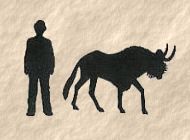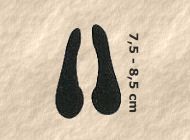 |
 |

Size

Footprint
|
Close this window to go
back to the previous page |
|
Description
|
A big antelope with a characteristic white
circle around the tail and a collar of white hair around the neck and the
snout. The rest of the body is grey-brown. There are white stripes on the
ridges of the eyebrows and the chin is white. The tuft on the end of the
tail as well as the lower legs are darker and more brown in colour. The hair
is shaggy, coarse and long. |
|
Sexual dimorphism |
Males are larger than females, which are
hornless. |
|
Habitat |
Areas near rivers or marshes and dry
floodplains. They are never far from water. |
|
Habits |
Waterbuck are diurnal, gregarious animals. The
small herds of 6 to 12 animals consist mostly of females, calves and young.
Males are territorial and while some remain solitary, others form male
herds. Serious fights between male Waterbuck are more common than similar
fights among other species of antelope. When danger threatens they take to
the water, even if there are crocodiles. Crocodiles do not usually attack
Waterbuck, probably on account of the unpleasant smell given off by their
skin. |
|
Voice |
Not often heard. Snoring sound when alarmed or
excited. Females call calves with a soft "muh". |
|
Breeding |
1, seldom 2, calves are born throughout the
year after a gestation period of ± 9 months. |
|
Food |
Grass, sometimes leaves and fruit. They drink
water regularly. |
|
Mass |
♂
250 - 270 kg
♀ 205 - 250 kg
|
|
Life expectancy |
± 14 years |
|
Length of horns |
Average ± 75 cm
Record 99,70 cm
|
|
Enemies |
Spotted Hyena, Lion, Cheetah, Hunting Dog.
|
|
Also known as |
Waterbok (Afrikaans)
Kobus ellipsiprymnus |
|
This
site is best viewed at 1024 X 768
Please report any problems to the Webmaster
Copyright © CoZania October 2004 |



